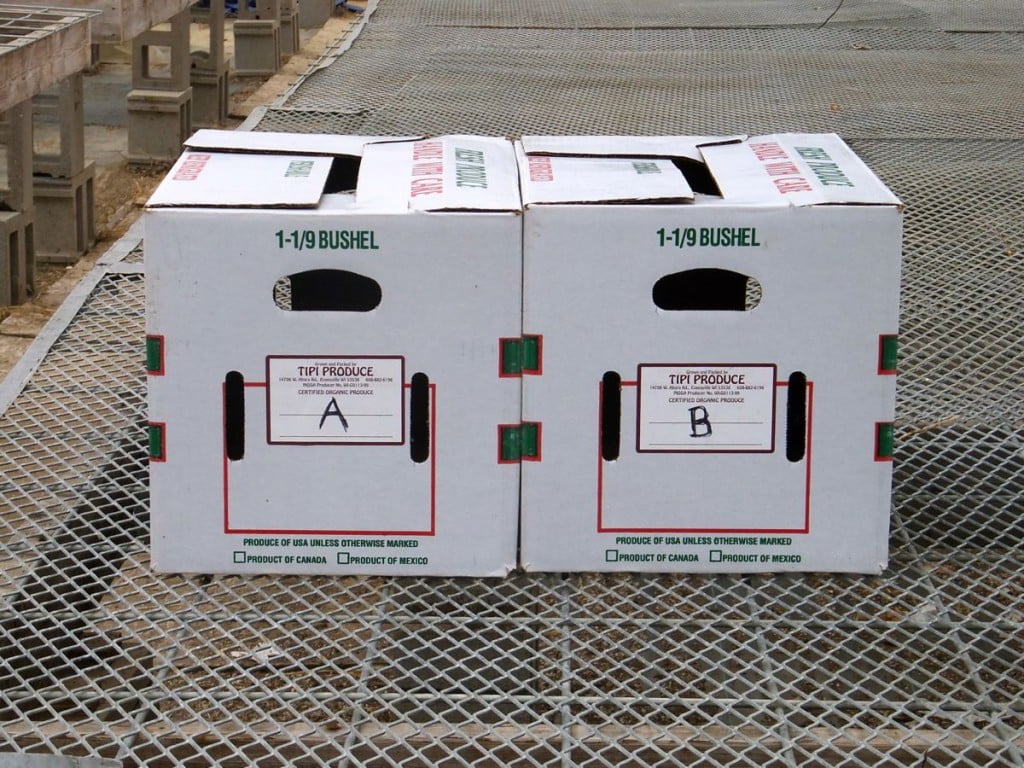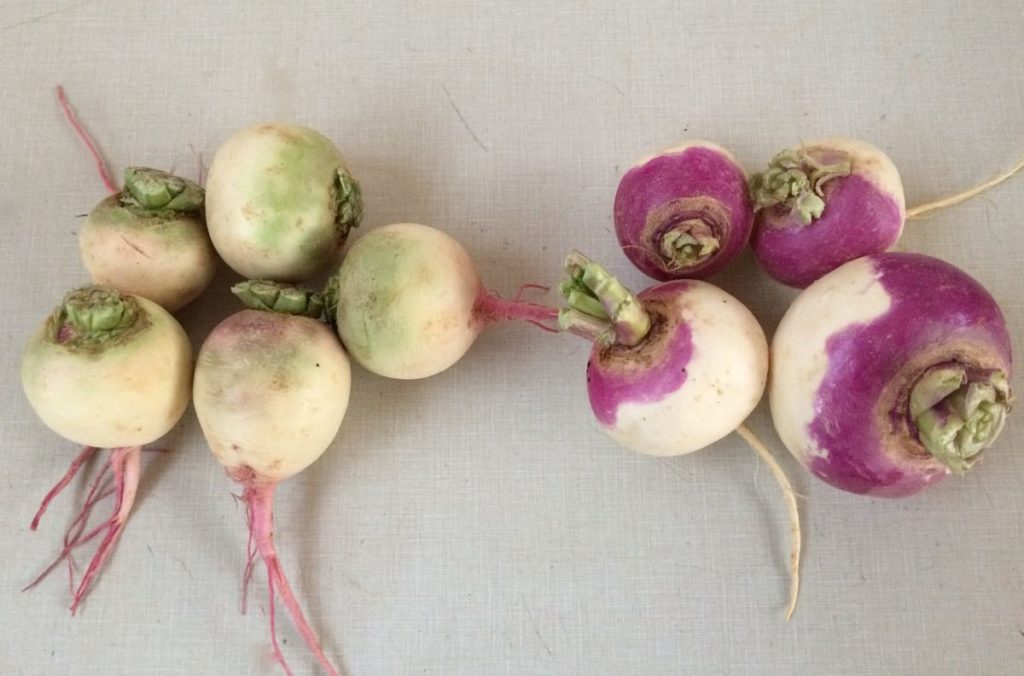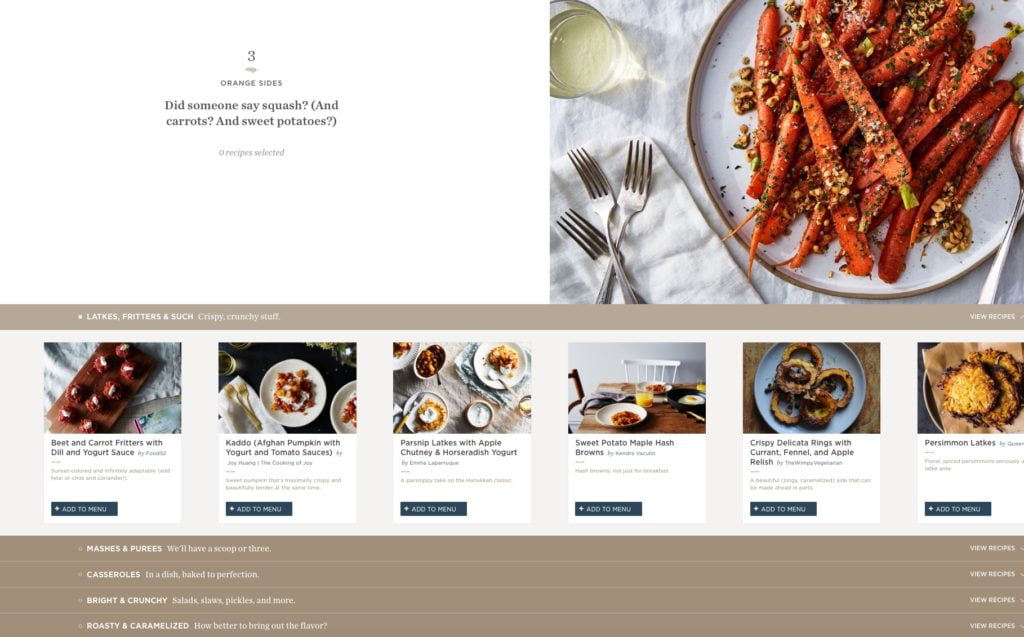Storage share, November 15/16, 2018
- On: November 14, 2018
 0
0
We are ready to wrap up this season. Then we’ll enjoy the winter, with lots of cooking, ice skating and skiing (we hope!) before beginning to plot next year. Have a wonderful Thanksgiving! Beth & Steve
Storage Share this week

Take one box labelled “A” and one box labelled “B”.
Things you need to know about your winter share
* Your delivery will consist of two different boxes, labeled “A” and “B”. Take one “A” box and one “B” box. The boxes contain different vegetables.
* Please pick up your boxes on the day of delivery, during the normal hours for your site.
* Outpost members, pick up your boxes on Friday. This is the busiest weekend of the year for the Outpost staff, so they WILL NOT hold boxes past Friday, nor can they handle special requests.
* Members at unheated sites, please replace the blankets carefully. That keeps everyone’s produce in good shape.
* The boxes are heavy! Bring lots of bags to take your produce home.
Veggie List and Storage Info (Storage share, Nov. 15/16, 2018)
We hope you enjoy this shipment of veggies. Strategize to use them well, as some will last longer than others.
* These are the most perishable vegetables: kale, cauliflower, Romanesco.
* These are the next-most perishable: Brussels sprouts, cabbage, leeks, turnips and onions. Keep an eye on your butternut, potatoes and sweet potatoes. The last two are susceptible to drying out. Expect the largest butternuts to last the longest.
* These will last the longest: Beauty Heart radish, beets, carrots, celeriac, garlic, parsnips.
Box “A”
Refrigerate everything in this box.
Beauty Heart winter radishes, ~1.5 lb
Beets, 3 lb
Brussels sprouts, on stalk
Carrots, 6 lb total
….. orange ~4.6 lb
….. yellow ~1.5 lb
Celeriac, 1
Green cabbage, 1 medium
Kale
Leeks, ~1 lb
Parsnips, 2.5 lb
Turnips, a few
Mixed Romanesco and purple or green or white cauliflower, 3 – 4 lb total
Box “B”
The Brussels sprouts and onions need refrigeration. Everything else in this box can be stored cool or at room temperature. See notes below for more detail.
More Brussels sprouts stalks
Butternut squash, 6 – 7 lb
Garlic, 2 beautiful bulbs
Potatoes, Amarosa fingerlings, 2 lb
Potatoes, russet, 5 lb
Potatoes, Satina, 5 lb
Sweet potatoes, ~10 – 11 lb
Onions, 5 lb total
….. ~1.5 lb red
….. ~3.5 lb yellow
Beauty Heart radishes (round, white with pale green shoulders and bright pink interior) – Refrigerate. The interior color is lovely. Slice thinly and add to salads, cook lightly in mixed vegetable medleys or cut into matchsticks and add to pasta salads. We enjoy grated carrot and Beauty Heart salads all winter.
Beets – Refrigerate in a bag or container. Beets will store for two months or longer.
Brussels sprouts – Pluck from stalks and refrigerate in a bag or container. Do this the day you pick up your CSA boxes. Eat within 2 to 3 weeks.
Butternut winter squash – You will receive 6+ lbs of squash total. Store your butternut in a cool, dry place. 55 – 60 F is ideal. Do not put in a plastic bag. Expect the largest butternuts to store the longest. Inspect your squash frequently and cook promptly if you see any soft spots developing. You can cook, mash and freeze the squash for future use. I find that you can refrigerate cut raw squash for up to one week. This runs counter to the accepted way to store squash, but is useful if you want to cook just half a squash. Try microwaving your squash for one to two minutes before cutting or peeling. This softens the squash and makes a large butternut easier to handle.
Cabbage – Refrigerate.
Cauliflower (white, purple or green) – Refrigerate in a bag or container.
Carrots, orange. Refrigerate in a plastic bag. Will keep for several weeks.
Carrots, yellow. This variety is pretty AND they taste good.
Celeriac – Will store for months in your fridge. Cut off chunks as needed. Peel before using. I find it easiest to cut the celeriac into flat slices, then peel.
Garlic – Store at room temperature.
Kale – This mature kale is best cooked, rather than used in salads.
Leeks. Refrigerate and eat within three weeks. Leeks are not a long-storage crop. You may need to strip off one or two outer leaves to freshen the leeks before you cook them.
Onions: Refrigerate or store in a cool, dark spot and protect from light. Exposure to light stimulates sprouting. If you have the room, it’s safer to store the onions in the refrigerator. After the wet season, they might not last as long as usual.
Parsnips (These look like large white carrots.) – Refrigerate in a plastic bag. Parsnips will store for two months but will darken in color. That is a harmless change.
Potatoes, fingerlings, russets and Satinas – Can be stored at room temperature or in a cool spot, but must be kept in the dark so they do not turn green. A cloth or loose plastic bag draped over the paper bag will help avoid moisture loss, but do not close the plastic bag. All three types will store longer if kept cool. Around 40 – 50 F is ideal. The potatoes were grown by the Igl family near Antigo.
Amarosa fingerlings – This is a new addition to the Storage share for us. These fingerling potatoes have red skin, marbled red flesh and a creamy, velvety interior when cooked. They are delicious fried, baked, boiled, or steamed. Fingerlings really shine when simply roasted. Cut in half, oil well and roast at 400 F until soft. Don’t try to make mashed potatoes; they will turn gluey.
Russets– We got the big ‘baking’ grade so you have nice bakers for Thanksgiving. Excellent for baked or mashed potatoes.
Satinas– These are good all-purpose potatoes, everything from roasted to potato salad. I really like this variety of yellow potato because they oven-roast so well and because they are less sweet than other yellow varieties such as Yukon Golds.
Sweet potatoes – These are a mix of the Beauregard and Covington varieties. All types have developed excellent flavor and sweetness. Store at room temperature, no lower than 55 F, but 60+ F is better. Keep them on your kitchen counter where it’s easy to keep an eye on them. I like to keep ours in a paper bag so they don’t dehydrate. Cook promptly if they start to soften. The roots come in a wide ranges of sizes and all are good.
Turnips (white roots with purple shoulders and white interior) – Refrigerate. Scrub clean but do not peel. Excellent roasted, or mashed or scalloped with potatoes.

Beauty Heart winter radish (left) and turnips (right).
These roots look similar but are quite different. Beauty Hearts are winter radishes with a beautiful magenta interior. Their shoulders are green, white or blush pink. In contrast, turnips (right in photo), have purple shoulders and a white interior.
What are you cooking for Thanksgiving?
We are creatures of habit when it comes to Thanksgiving. Here are our plans so far:
– brined roast heritage turkey from our friends Jen and Bryce Riemer (Beth),
– Brussels sprouts with garlic-mustard vinaigrette (Steve),
– roasted sweet potatoes with garlicky yogurt sauce (Sophie),
– glazed butternut squash (Beth),
– crunchy carrot-Beauty Heart salad with sesame-seed dressing (Steve),
– some kind of slow roasted onion relish (Beth),
– homemade applesauce (Ari), and
– apple pie (Sophie).
I’ll probably make stuffing with lots of celeriac and onions but that might be overkill. Yeah, we tend to go overboard. We love celebrating Thanksgiving and the end of harvest season.
Menu Ideas
This is a great time of year to gather recipes to enjoy all winter. Online cooking sites post Thanksgiving menus and recipes, many suited to your Storage share vegetables. Peruse and bookmark the recipes soon; Thanksgiving collections are taken down quickly after the holiday.

Food52’s Thanksgiving Menu Maker.
♦ IMHO, the lively Food52.com site has the best Thanksgiving recipe collection this year, possibly of all time. It’s titled AutoMagic Thanksgiving Menu Maker, and is beautifully organized by type of dish. Go straight to Section 3, “Orange Sides”, with multiple subheadings such as “Bright and Crunchy Salads” or “Roasty and Caramelized.” Move on to “Something Green” or “Gravies & More” or other tempting sections. I plan to gather a suite of recipes to try this winter.
♦ Smitten Kitchen is our go-to site for dessert recipes but has excellent veggie recipes too. Blogger Deb Perelman often posts her own plans for new Thanksgiving feast. This year, she has simply posted a collected list of Thanksgiving recipes from previous years. It is extensive!
♦ 101cookbooks. Always has good vegetarian and whole-grain recipes.
♦ The Dishing Up the Dirt site doesn’t have a specific Thanksgiving section, but many of her recipes are tailored to Storage share produce.
♦ Finally, remember that we can use Local Thyme recipes all winter. Check them out for Thanksgiving ideas.



